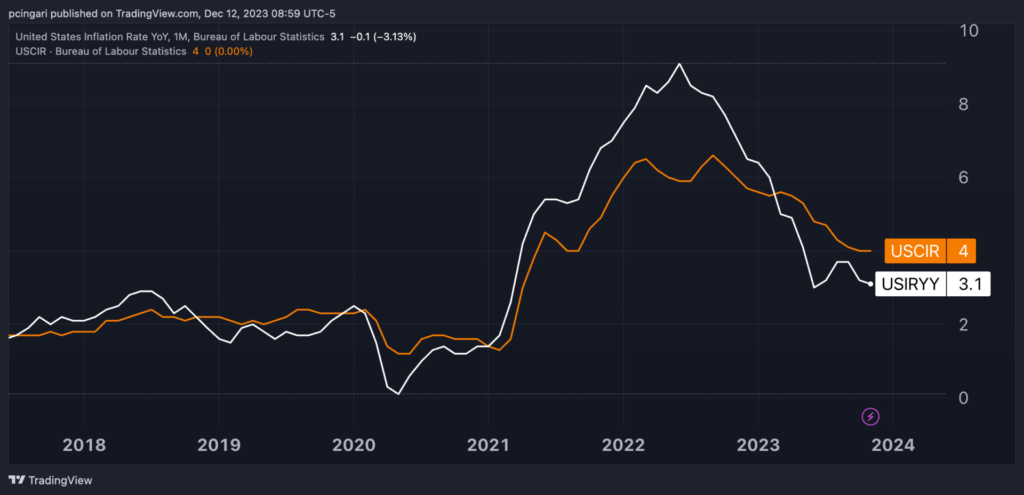Zinger Key Points
- November CPI report indicates mixed inflation trends, with headline inflation easing slightly while core prices remain steady.
- Experts weigh in, highlighting concerns about persistent inflation, consumer health, and the Fed's policy strategy.
- Every week, our Whisper Index uncovers five overlooked stocks with big breakout potential. Get the latest picks today before they gain traction.
The latest Consumer Price Index (CPI) report for November revealed a mixed inflation picture.
What Happened: Headline inflation eased slightly, as expected, but core prices held steady, likely indicating some friction in the ongoing disinflation trend.
Economists and market analysts weighed in on what these figures mean for the Federal Reserve’s policy trajectory and financial markets.
Key CPI Data Highlights
- Annual Headline CPI: Eased to 3.1% in November, down from 3.2% in October, as expected.
- Monthly Headline CPI: Increased by 0.1%, slightly above expectations of a flat reading
- Annual Core CPI: Remained steady at an annual rate of 4%, as forecasted.
- Monthly Core CPI: Advanced at a 0.3% pace, up from October’s 0.2% and in line with expectations.

NorthEnd Private Wealth‘s Alex McGrath expects the Federal Reserve to maintain its firm stance against it. The chief investment officer also says Fed Chair Jerome Powell will likely reiterate how the battle against inflation is not over.
Concerns about consumer health remain. U.S. households are already grappling with soaring credit card balances and historically high-interest rates. McGrath also questions the sustainability of current stock market valuations and the Fed's strategy for managing its sizable balance sheet.
The Kobeissi Letter pointed out how inflation remains high when it comes to car insurance, transportation, and housing. This poses a continued challenge to consumers and policymakers.
- Car insurance (19.2%)
- Transportation (10.1%)
- Rent (6.9%)
- Food away from home (5.3%)
The “Core Services Ex Housing Inflation,” a measure highly watched by Fed officials, jumped 0.44% in the past month, corresponding an annual rate of approximately 5.3%, significantly higher than the headline CPI. Therefore, they do not expect any imminent Fed dovish shift.
Kathy Jones, chief fixed income strategist at Schwab Center for Financial Research, saw the CPI trending lower, but she believed it would not prompt the Fed to discuss rate cuts just yet. She acknowledged that the direction of travel appeared positive, but the destination remained out of reach.
Chris Zaccarelli, chief investment officer for Independent Advisor Alliance, saw the CPI report as unsurprising, highlighting the sole anomaly of a 0.1% monthly increase compared to the anticipated flat reading.
Zaccarelli was confident that the Fed would maintain its current stance well into the next year and might not consider rate cuts until the second half of 2024. He dismissed concerns about elevated core inflation, believing the Fed would patiently wait for it to recede while focusing on the robust economy.
Jamie Cox, managing partner for Harris Financial Group, emphasized that higher interest rates have been effective in achieving the desired outcome. However, he also pointed out the delicate balance the Fed must maintain to avoid inadvertently stalling the economy into a recession.
According to Cox, the Federal Reserve now faces the challenge of navigating a narrow path to prevent such a recession from occurring.
Quincy Krosby, chief global strategist at LPL Financial, noted that the Federal Reserve will likely remain cautious about declaring a complete victory. “Sticky” inflation is slower to unwind.
The Fed is likely to keep its options open, particularly if the battle against inflation hasn’t reached its more challenging “last mile,” Krosby wrote.
The central dilemma for the Federal Reserve lies in the potential consequences of cutting rates too early and then being compelled to raise them shortly afterward.
Market reactions: Rate expectations were mostly unchanged following the inflation report, and Treasury yields held steady. Markets continue to expect the Fed starting to cut rates in May 2024, and are almost pricing in five rate cuts by December 2024.
The U.S. dollar index (DXY), as tracked by the Invesco DB USD Index Bullish Fund ETF UUP, fell 0.1%. The SPDR S&P 500 ETF Trust SPY was flat, while the tech-heavy Invesco QQQ Trust QQQ was a tad higher.
Read more: Federal Reserve Meets Wednesday: Will Powell Signal Rate Cuts In 2024?
Photo via Shutterstock.
© 2025 Benzinga.com. Benzinga does not provide investment advice. All rights reserved.
Trade confidently with insights and alerts from analyst ratings, free reports and breaking news that affects the stocks you care about.